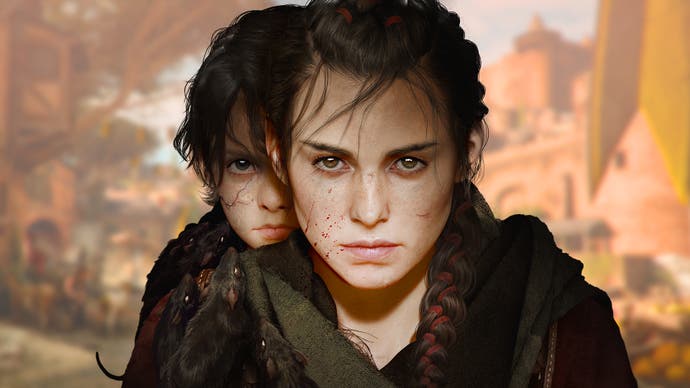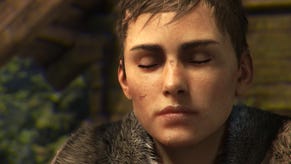A Plague Tale: Requiem is a beautiful tech showcase that pushes the consoles hard
A visually demanding game sees Xbox Series X deliver the smoothest experience.
Two years on from launch, games developed just for PC, PS5 and Xbox Series hardware are still a relative rarity, an event to be savoured. Asobo Studio's A Plague Tale: Requiem certainly hits the mark though: an absolutely beautiful game that does actually feel like a generational leap over its predecessor. We're looking at the console versions today even though PC pushes the game even further - but we're waiting to see what the forthcoming ray tracing upgrade will deliver before going deeper on that version.
Technically, mechanically and even narratively, Requiem is a massive improvement over the already impressive debut game. The mix of stealth and puzzle-solving returns, but it's more robust and varied, offering you larger areas to carve your own path than the original. The visuals are an immense improvement with an extraordinary level of detail, phenomenal materials work and absolutely sublime lighting. Then there's the series' signature hoards of rats. In the original, Asobo's engine rendered 5000 rats on-screen at once, their detail scaling down the further you go into the distance. But now? In the sequel it's pushed to a quite excessive 300,000 - with the team altering their movement to look more like a tidal wave as they burst through gaps.
There has been a debate about Requiem being just a 30fps game on PS5, Series X and S. It's capped at 30fps on 60Hz displays specifically on console - or 40fps capped if you have a 120Hz display hooked up to any of them. Either way, some are disappointed it's not running at 60fps by default. To an extent it's understandable. Bear in mind the original game - A Plague Tale Innocence - ran at 60fps on PS5, Series X and S, it's a step backwards of sorts. However, this is the price we have to pay for the level of enhancements delivered by this game - and based on a cursory look at the PC version, it's pushing CPU and GPU hard, meaning that simply reducing resolution for a higher level of performance isn't going to work.
It's clear the team makes the most of a jump to new hardware. On PS5 and Series X, Asobo Studio has the horsepower to open these levels out, into huge sprawling areas. You get more agency. But equally, the scenery is packed more richly with detail. Looking at Requiem's own opening area, there's more foliage drawn far, far to the distance. You get higher quality material interaction with light, indoors and out. There's more complex geometry, and density of objects strewn around the field, plus parallax occlusion mapping.
A few other details stand out too: the pin-sharp skybox overhead is stunning in its large overviews of cityscapes. Even the early market area is energised with a huge number of NPCs, a vast upgrade on the original game's sparsely populated towns. Character models get a big uplift in quality, too. In both geometry and materials, our lead character Amicia in close-up shows a boost in texture resolution for clothes, improved skin shaders, and hair complexity. All combined across the game's often torchlit areas, Requiem's interplay between materials and lighting is a real spectacle this time around.
Image quality stats are a close match to the first game. Both PS5 and Series X each stay in place at a native 1440p resolution, reconstructing up to 4K using a temporal solution. For Xbox Series S, we're again sticking to 900p as the native figure, in line with Innocence. The upshot is that nothing is lost or gained in terms of the raw pixel metrics. Clearly the sequel is pushing for higher settings, and bigger environments as a way to use these system's resources. If we compare Series S directly to Series X though, there are a few settings dropped for the weaker machine. Ambient occlusion takes a hit, leading to less shaded foliage, while foliage in general appears less dense at range. Otherwise, this is the same game across all three platforms, though PS5 does make good use of the DualSense adaptive triggers.
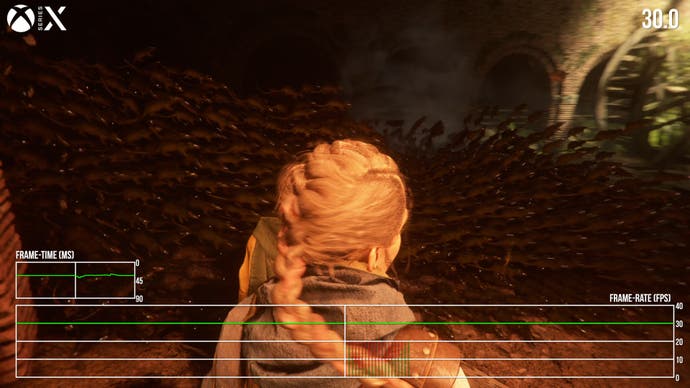
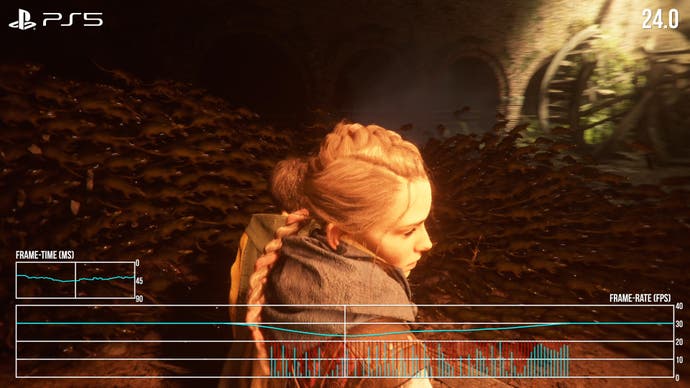
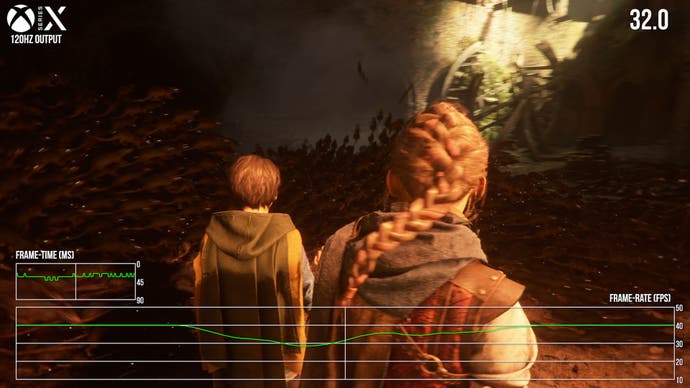

Performance is a touch controversial because not only does the game target 30 frames per second, it can actually fall short of the number. At least the 30fps update is evenly frame-paced, with adaptive screen tearing kicking in on all three when the engine's pushed. I'd also stress that 95 percent of the time you're getting a smooth 30fps line here with no issues. Xbox Series X is the best, and most consistent performer of the three, and I've barely seen much more than a single frame drop here, even in the most taxing spots. The emergence of rats is a big stress point in the game, typically, and it barely shows a blip on Series X. It's not as pretty a picture with PlayStation 5, however, which offers up a less stable 30fps release all round, though largely still very solid.
If we're picking out the worst points for comparison, scenes involving masses rats and guards in outdoors areas do cause the biggest problems on the Sony machine. Equally, Series X's flat 30 clearly drops into the mid-20s on PS5 in areas involving heavy transparency effects - like fire. The majority of play is still 30fps, but expect the drops to be that much more regular on PS5 in its current state. Curiously the Series S release falls in between the a huge. In overall consistency it's closer to Series X in overall robustness, again barring select moments with a huge surge of rats. In terms of performance, the drop to 900p on Series S does appear to be well judged, and a benefit in the visuals/frame-rate balance.
There is a twist in that running the game on a 120Hz display changes the frame-rate target to 40 frames per second, not 30, while retaining the same pixel counts. Series X runs parts of the game just fine at the full 40fps cap, though we also see why 30fps is the more realistic target on console. The areas with heavy fire, the stronghold with all the guards and rats in view, the sudden surges of rats: all drop Series X to the 30fps line, or at least kissing the top of it briefly.
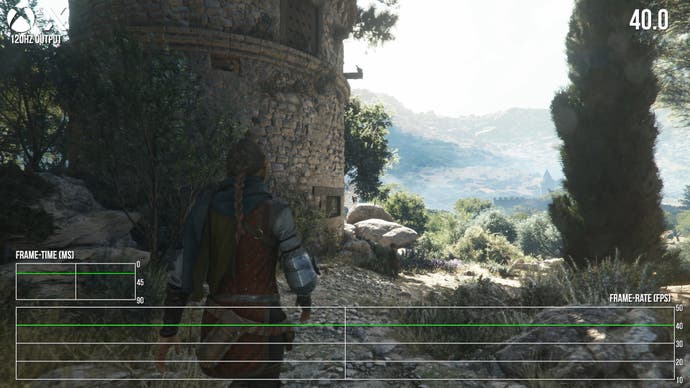
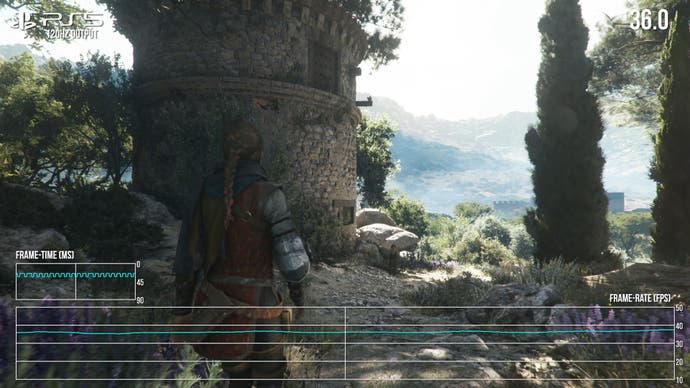
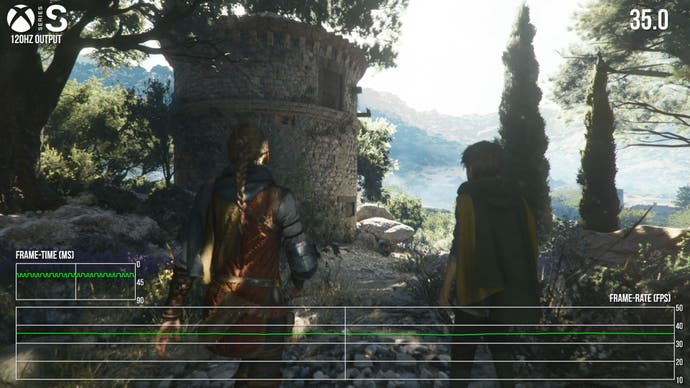
This isn't ideal of course, but it highlights realistically how far these consoles are from the 60fps line. PS5 expectedly is even further off the mark from hitting a stable 40fps and in the stress points, it can even dip into the 20s. And likewise on Series S where stability at 40fps just isn't a given, outside of the quieter moments in the towns, there's an argument that maybe 30fps on a 60Hz screen may well be the better option overall. The fact that a 40fps target is available is welcome, but dynamic resolution scaling may have helped both 30fps and 40fps modes overall.
Performance shouldn't be the final word on A Plague Tale: Requiem. The game really is a technical feat - a real standout visually on PS5 and Series X. Asobo's latest is remarkably tight in its mechanics and commits to a superb story. As far as console recommendations go, if you've the luxury of choosing, go with the Series X release for now - purely for being the more stable release. PS5 runs acceptably overall, just expect moments with obvious performance drops at the peak of action. I'd seriously hope for a fix, because usually the divide between the two isn't so apparent in multi-platform releases. And as for Series S, it's an accomplished release overall, with only the blurrier image quality detracting from its many merits.
Tighter performance at 30fps would be welcome as would a more stable 40fps presentation for 120Hz displays, but if you're looking for a genuinely stunning game that truly showcases what the latest consoles are capable of, A Plague Tale: Requiem is highly recommended.
